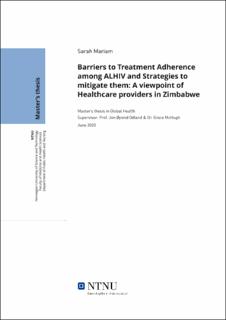| dc.description.abstract | Introduction
Although Anti-retroviral Therapy (ART) has succeeded in lowering mortality rates among all age groups in Zimbabwe, despondently, mortality rates among adolescents living with HIV (ALHIV) have remained the same. With a well-documented poor adherence to ART, ALHIV have higher mortality rates, making non-adherence to ART among ALHIV a global public health problem. This paradoxical increase in mortality among ALHIV demands research into the exploration of obstacles faced by adolescents living with HIV in Zimbabwe in adhering to ART. This study aims at assessing barriers to treatment adherence among ALHIV living in Zimbabwe, in order to propose effective and efficient strategies for improving ART adherence among them.
Methodology
To comprehend the antecedents behind this phenomenon, a descriptive qualitative study, consisting of 18 face-to-face, semi-structured, in-depth interviews were employed. Data was collected through purposeful sampling from healthcare providers (9 counsellors, 6 nurses and 3 medical doctors) working under the BREATHE trial of Biomedical Research and Training Institute (BRTI) and from three health facilities; Harare Central Hospital, Parirenyatwa Hospital and Rutsanana Poly Clinic, in Harare, Zimbabwe. Following the interpretive paradigm, an inductive approach was used to analyze data through Thematic analysis, which resulted in formation of four themes.
Results
The four themes discovered, depicted the barriers to treatment adherence among ALHIV, i.e. Social, Healthcare system, Medication and Individual barriers. Data analysis and interpretation of results showed that, simultaneous to the formation of treatment non-adherence by these barriers individually, there also lies an inter and intra-relationship among the barriers, where one barrier instigates the formation of other barriers. Among the barriers revealed, Social barrier was found to be the most diverse and overarching barrier that instigates all other barriers.
Conclusion
The recognition of treatment adherence barriers identified through this research, resulted in formation of effective strategies, intended for all stakeholders involved in the treatment of ALHIV. The inter and intra-relationship model found through this research, underscores that the social barriers emerge as the most pronounced obstacles in treatment adherence of ALHIV at numerous levels. Therefore, social barriers must be culminated, in order to prevent the aggravation of other barriers. The proposed strategies, hence, also serve to direct the formation of prospects for future research to improve ALHIV’s adherence to ART.
Keywords: HIV, ALHIV, Anti-retroviral Therapy, Treatment Non-adherence. | |
